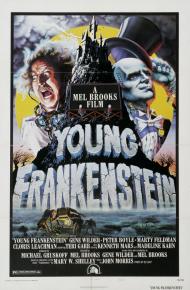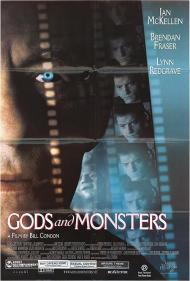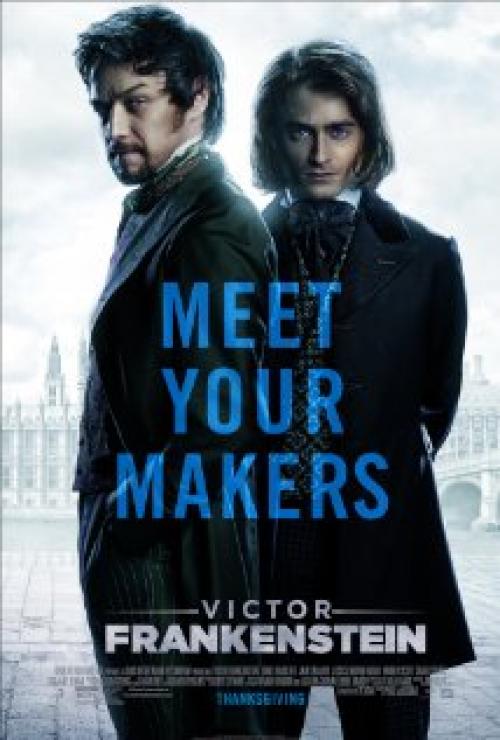Movie Review
The Bride of Frankenstein
The Monster Talks and Demands A Mate!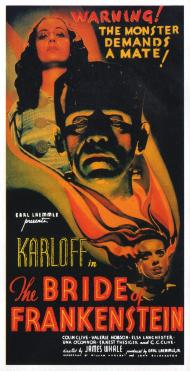
US Release Date: 04-22-1935
Directed by: James Whale
Starring▸▾
- Boris Karloff, as
- The Monster
- Colin Clive, as
- Henry Frankenstein
- Valerie Hobson, as
- Elizabeth Lavenza
- Ernest Thesiger, as
- Doctor Septimus Pretorius
- Elsa Lanchester, as
- Mary Wollstonecraft Shelley/The Monster's Bride
- Gavin Gordon, as
- Lord Byron
- Douglas Walton, as
- Percy Bysshe Shelley
- Una O'Connor, as
- Minnie
- E.E. Clive, as
- the Burgomaster
- Lucien Prival, as
- the butler
- O.P. Heggie, as
- Hermit
- Dwight Frye, as
- Karl
- Reginald Barlow, as
- Hans
- Mary Gordon, as
- Hans' wife
- Anne Darling, as
- the shepherdess
- Walter Brennan, as
- Neighbor
- Billy Barty, as
- Baby
- John Carradine as
- Hunter at Hermit's Cottage
![3.25 star[s] out of 4](http://www.threemoviebuffs.com/static/images/global/featured_gold_stars.png)
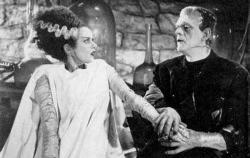
Elsa Lanchester and Boris Karloff in The Bride of Frankenstein.
This sequel to Universal's 1931 hit Frankenstein almost didn't happen. It took four years for the studio to finally convince James Whale to agree to direct. He acquiesced only after the studio granted him complete creative control. The result is one of those rare sequels that is equal to -or even surpasses- the original. Whereas Frankenstein was a straightforward gothic horror movie, The Bride of Frankenstein is a campy hoot, with excellent work done by the cameraman, art director, and composer of the original score to boot.
It begins on a dark and stormy night as Mary Shelley, her husband Percy and their guest Lord Byron discuss her story about a scientist who creates a living creature from dead body parts. They remind her that her intention was to impart a moral lesson and she assures them her story isn't finished. The scene then shifts to the ending of the original movie. As Henry Frankenstein's injured body is carried home from the burning windmill, several villagers stay behind to ensure the monster was destroyed in the fire.
These include the parents of the young girl drowned by the monster in the first movie. To their dismay the monster is still alive and it kills them both before chasing off Minnie (Una O'Connor) and escaping into the nearby hills. Meanwhile Dr. Frankenstein's old mentor, one Dr. Septimus Pretorius, arrives unexpectedly and in the course of the evening shows Henry the results of some of his own bizarre experiments. The doctor has grown several homunculi (miniature humanoids) which he keeps in glass tubes. These include a queen, king, archbishop, devil, ballerina, and mermaid. It is he who suggests they create a female mate for the monster.
Anyone who has seen Young Frankenstein but hasn't yet seen this movie has a treat in store. The hilarious scene where the monster visits a blind hermit originated in this movie. After watching it you will realize that Mel Brooks didn't really have to exaggerate much at all as this movie is in some ways a parody itself. The hermit teaches the monster a few rudimentary words like “friend” and “good” and basically civilizes him a bit. Until two hunters show up and chase the monster off.
Much has been written about the Christian imagery Whale included. Crucifixes are visible in several scenes and the monster is trussed up in a crucifixion pose at one point, and his last meal is bread and wine. Other film scholars have focused more on what they perceive to be a gay sensibility running throughout the film. Whale was a homosexual and it was rumored that both Colin Clive and Ernest Thesiger were gay in real life as well. The character of Dr. Pretorius is often assumed to be gay while the relationship between the monster and the blind hermit has been described as a same-sex marriage that is intruded upon by the hostile outside world. Both of these theories add some interesting subtext to the movie but neither is essential to the enjoyment of it.
One thing that elevates the camp aspect of this movie is the fact that the monster talks, although with a very rudimentary vocabulary. Boris Karloff was against this idea but he was overruled by Whale. This decision actually adds a layer of depth to the story but it also affected the way the monster looked. Because he had to speak for the role Karloff could not remove his partial bridgework as he had done in the first movie and which gave the monster that sunken cheek appearance.
The titular bride (so memorably played by Elsa Lanchester) only appears for a few minutes but her impact and legacy have been huge. Her look is iconic with that long white robe, and her famous shock hairdo with the streaks of lightning on both sides of her head. Lanchester said she based those eerie screeches on swans she had observed swimming in a pond. This is also the movie where the line, “To a new world of gods and monsters!” is declared by Dr. Pretorius. Gods and Monsters was used for the title of the 1998 biopic about James Whale.
The Bride of Frankenstein is widely regarded to be James Whale's masterpiece. It is 75 minutes of highly entertaining thrills and unabashed camp.
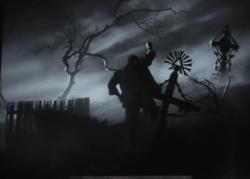
Boris Karloff in The Bride of Frankenstein.
Although, like Patrick, I found this movie to be enjoyable, it doesn't come close to being as good as the original. That earlier film was dark and atmospheric while this movie, although occasionally creepy, is far more campy and unintentionally funny than it is scary. It really does feel like Whale was sending up his own work. And, by altering the ending of the original to allow both Frankenstein and the monster to live for this sequel, it weakens the impact of the original's ending.
That doesn't mean that there aren't many great things about this film. The look of it is quite good. It's not as dark as the original, but Whale does make good use of light and shadow. The monster makeup remains quite good and Karloff is still terrific as the monster. The theme of loneliness and a "monster" struggling to fit into society provides some great subtext. Many have seen this as Whale's symbolism of a gay man trying to fit into society.
You can definitely see why viewers have picked out homosexual imagery from the film. One scene in particular that struck me while watching is when the Monster lays down on the Hermit's bed and the Hermit bows his head in prayer. The chosen camera angle from behind the Hermit, who's head is at crotch level with the Monster, makes it appear as if he could be giving him a blowjob.
Ernest Thesiger is quite creepy as Doctor Pretorius, even if he is often over the top. When he comments on how the corpse must have been quite pretty once, he manages to make it sound as if he might still find the corpse attractive. Unfortunately, his character also provides one of the film's silliest scenes when he produces living miniature humans in bottles. This is truly the film's most "what the fuck?" scene.
The biggest difference between this film and the original Frankenstein is the amount of humor. Despite the fact that the monster kills a few people, I wouldn't even call this a horror movie. It's much more of a comedy, both intentionally and unintentionally. It's definitely entertaining, but not without its flaws.
![3 star[s] out of 4](http://www.threemoviebuffs.com/static/images/global/featured_gold_stars.png)
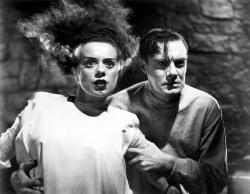
Elsa Lanchester and Colin Clive in The Bride of Frankenstein
I watched this Universal classic horror film late last night and it begins perfectly, just as Patrick described, “…on a dark and stormy night…” It then shows the monster as he continues his night of terror. I was sucked in and on board for a trip to old Hollywood horror land.
However, it seems that Whale was not trying to make a horror film at all, but a comedy. Una O'Connor’s insistent screaming quickly became more annoying than fearful. Everyone over acts and like Scott, I found Doctor Pretorius’s living miniature humans in bottles to be more ridiculous than fascinating. “I grew my creatures, like cultures, grew them as nature does, from seed.” I am with Scott. WTF!
I guess you can enjoy this movie as a campy comedy or a silly old horror film. Patrick wrote that Boris Karloff was against having the Monster speak but Whale thought otherwise. It almost seems as if they were at odds during production. Whereas Whale is directing a farce, Karloff is playing it straight. He was able to convey sentiment and emotion without such silly dialogue as, “I want friend like me.” and “Alone: bad. Friend: good!”
No matter how you see this film. You must agree that the scene near the end where the bride finally makes her appearance is one of the most classic in Universal horror movie history. She moves her head about as if trying to learn how her body works. She sees the monster and does her famous scream. My favorite part of the scene is when the monster says, “She hates me.”
If you do not take any of this too seriously, you will enjoy The Bride of Frankenstein. It is a must see for black and white film buffs. The final scene of the film alone makes it worth the watch.
Photos © Copyright Universal Pictures (1935)


